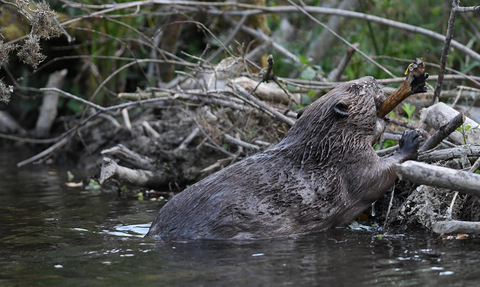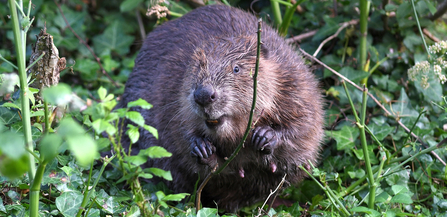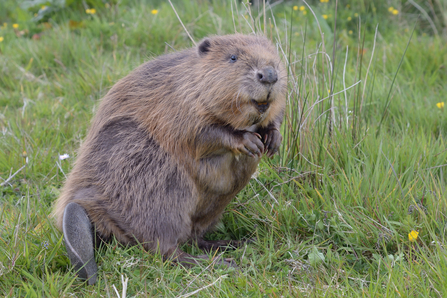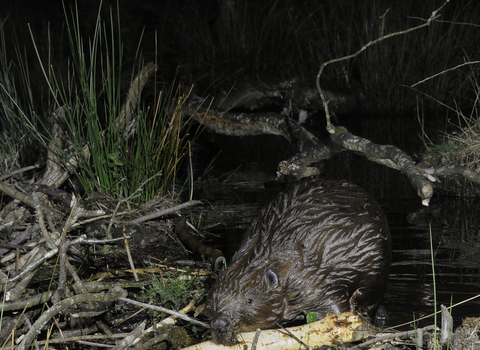
© David Parkyn/ Cornwall Wildlife Trust
Cumbria Beaver Group
The Cumbria Beaver Group is made up of Cumbria Wildlife Trust, RSPB, Lowther Estates and Eden Rivers Trust and is working in consultation with Natural England, the Environment Agency, United Utilities, Forestry England, the University of Cumbria and others.
The aim of the group is to facilitate the well planned and managed reintroduction of beavers to Cumbria through the delivery and support of enclosed scientific beaver release trials, as well as community engagement and advocacy.
- Beavers are native to Britain but were wiped out in the 16th century, mainly due to hunting.
- Beavers are completely vegetarian and do NOT eat fish.
- Beavers can provide a range of environmental and socio-economic benefits. These include flood risk alleviation, improved water quality, habitat creation for other wildlife and increase revenue for the local economy through nature-based tourism.
- A licence for an enclosed scientific release at Lowther Estate in Cumbria was approved in January 2020. It is not for free roaming beavers so they will be unable to move into the wider surrounding countryside.
- In the long term, the Cumbria Beaver Group would like to see beavers return to Cumbria. However, it is vital that any reintroduction is well planned, well managed and has the support of the local community.

© David Parkyn/Cornwall Wildlife Trust
Are there beavers in Cumbria?
Yes! A pair of Eurasian beavers were introduced to the Lowther Estate in summer 2020, in a licensed, enclosed scientific release.
A second licence was agreed for a private site in South Cumbria in 2020. Feasibility studies will be undertaken at other potential sites across the county.
Can I visit the Lowther beavers?
The pair of beavers at Lowther Estate are in a private area to avoid disturbance, so open access to the public is not permitted.
Why are the beavers in an enclosure?
Currently, the central government in England supports enclosed scientific trials of beavers, which are an excellent tool to inspire and educate the local community about this species. The secure enclosure at Lowther is made with a high standard of fencing, to meet the requirements of the licence. This secure enclosure will protect beavers and ensure their safety during the trial.
Do you want to see free-living beavers in Cumbria?
The proposed trial releases, along with other trials around the country will feed into the development of government policy for beavers in England in the longer term. Depending on the outcome of these trials, the Cumbria Beaver Group will advocate that any reintroduction is well planned, well managed and has the support of the local community.
There are already a number of enclosed trails taking/ have taken place in the UK. What extra learning can you achieve from yet another beaver trial?
The Cumbria trials will look specifically at how beavers fare in an upland environment and examine how they interact with peatland soil. The proposed trials are all at a large scale, allowing impacts to be assessed at something closer to the landscape level. The trials are also effective to educate and inspire communities in Cumbria about the return of beavers.
If you want to see beavers in the long term, isn’t the scientific trial is just paying lip service?
Any enclosed trials in Cumbria will contribute to the English Government’s understanding of beavers and would play a role in its decision making around granting licences for free-living beaver releases in the future.
What impact do beavers have on the environment?
Beavers modify the habitats and landscapes in which they live. In the first instance, these changes can markedly alter the appearance of the local environment but research indicates a positive overall ecological functioning of catchments and river systems.
Beaver adaptations can bring enormous benefits to other species, including otters, water shrews, water voles, birds, invertebrates especially dragonflies, and breeding fish. Beavers naturally create and maintain diverse habitats providing catchment resilience and climate change adaptation. Their leaky dams can hold water in periods of drought, and can regulate flooding by slowing water flow. They can also improve water quality by holding silt behind dams and catching acidic and agricultural run-off.
Beavers forage close to water with activity usually concentrated within 20m of the water’s edge. Beavers fell primarily broad-leafed trees and bushes, in order to eat the cambium (a thin layer between the bark and wood) during the winter and to construct their lodges and dams. Most coppiced trees will regenerate, diversifying the surrounding habitat structure.
In some locations and circumstances, beavers require direct management intervention by people. A range of mitigation and management techniques are available such as installing overflow piping on dams to alter pool height, and wrapping trees in wire mesh to prevent gnawing. Beavers rarely eat conifers, although they can be felled by beavers as an emergency forage in rare instances, and immature animals may attempt gnawing before quickly learning that they are unpalatable and unsuitable, due to the tannins and sap present. Beavers generally do not live in water entirely surrounded by conifers.
Impacts from burrowing on banks absent of trees, i.e. collapsed banks, are a factor on the Tay and have been cited by some anglers.
Do beavers cause damage to farmland and the wider countryside?
Evidence from Europe shows that shows that beaver damage is, in the vast majority of cases, small-scale, but they can forage crops close to rivers, cause bank erosion and collapse, and localised flooding. Beavers are not regarded as pests in Europe and where localised problems have occurred, there are a number of well-established methods in place. These include the removal of dams, the introduction of overflow piping, or the installation of fencing (as one does for deer and rabbits).
Do beavers pose a flooding threat?
In general terms, beavers can actually help reduce the risk of flooding lower down in river systems by building dams and moderating water flow in smaller catchments. The modifications made to the streams can raise the water table locally, creating wetland areas to the benefit of biodiversity. Evidence from elsewhere in Europe shows that instances of beaver dams creating undesirable flooding are uncommon, localised and usually small-scale. In these situations, dams may be removed or flow devices are placed through them to manage water levels.
Do beavers eat fish?
No. Beavers are herbivores. They eat woody plants and cambium from trees, aquatic plants, grasses and shrubs.
Do beavers affect fish species?
Beaver activities may have both positive and negative impacts on different fish species. Understanding the overall impact is complex. Beaver dams may act as barriers to migratory species such as salmon in some years and conditions, and cause localised siltation upstream of dams, affecting spawning habitat. On the other hand, positive impacts may include an increase in habitat variability for fish rearing and overwintering, an increase in refuge areas during high and low flow periods and an increase in aquatic invertebrate prey species. Furthermore, beaver dams can help improve water quality downstream of the dams, which can benefit fish. Read more about the potential impact on fish by the Scottish Wildlife Trust.
What impact do the beavers have on water quality and hydrology?
Research suggests that ponds and water pools created from beaver dams can have marked benefits on local water quality. The ponds can help to neutralise acidic run-off, act as sinks for pollutants and increase the self- purification of a watercourse. They can form considerable sediment traps, reducing very strongly erosive run-off and particulate loads in downstream water.
What evidence is there that beavers ever lived in Cumbria?
A Vertebrate Fauna of Lakeland by Macpherson, Rev. H. A., 1892, refers to a visit to the Cumberland Geological Society which indicates that beaver remains were found in the ‘Ressendale Valley’ (this is how Ravenstonedale was pronounced). This is indicative of a more widespread distribution.
Do beavers carry disease?
Beavers can carry host-specific parasites not currently present in Britain, though these are not known to infect or harm other species of wildlife, livestock or humans. Other parasites carried by beaver are already present in British wildlife, livestock and humans and these other sources of infection pose a more significant risk to water contamination than beavers. All beavers introduced to a site as part of a scientific trial are health screened.
Is there a risk of beavers dying during the trials?
Before introducing beavers to any trial, they are required to be thoroughly health-checked. However, beavers are wild animals and so there is always a risk that they may die at any time from natural causes.
Beavers in Britain today
Licensed, free-living beavers first returned to the UK in 2009 with the Scottish Beaver Trial in Knapdale Forest, Argyll. In November 2016 the Scottish Government announced that the beavers could remain and expand naturally from Knapdale and a previously established population on the River Tay, marking their formal reintroduction in Scotland. In May 2019, Beavers were afforded legal protection as a European Protected Species by the Scottish Government.
A licensed, free-living beaver trial in England on the River Otter in Devon concluded in 2020, when the Government gave them permanent right to remain. We are waiting for Defra to produce an England beaver strategy which will provide a roadmap for their future across the rest of the country. Many member organisations in the Cumbria Beaver Group advise on this strategy.
There are other enclosed trials currently taking place in England, as well as others in development.
Please send any beaver enquiries to email@cumbriawildlifetrust.org.uk

Beaver at Cornwall Beaver Project © Nick Upton/Cornwall Wildlife Trust
Cumbria Beaver Group members:

Cumbria Beaver Group consulting organisations:


